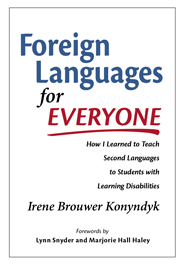These are the questions I ask of each student who wants to be considered for admission to the sequence:
Tell me something about yourself (to break the ice)
- What is your major / class level?
- What do you hope to do with your major?
Tell me about your prior foreign language history
- Elementary school? High school? College?
- Which language(s)?
- What did you find difficult? (spelling? vocab? grammar? listening? memorization? speaking? putting it all together? pace?)
- How would you rate these areas (spelling, vocab, grammar, memorization, etc.) in English?
If student has a low GPA — what are you doing to raise it?
What kind of services do you get from the learning disabilities office (e.g. academic advisor, college learning skills courses, etc.)?
Are you eligible for any accommodations (e.g. notetaker, extended time on tests, distraction-free environment, etc.)?
When do you hope to graduate? Any reason why you need the sequence this coming year rather than waiting until the following year (e.g. student teaching, internship during senior year, etc.)?
If student took a prior foreign language at Calvin and did poorly, I explain the policy of replacement grades. (Students can use the grades received in the modified foreign language sequence to replace grades in a different language, thereby raising their overall GPA.)
Explanation of the course sequence. I write the broad strokes of these comments on the reverse side of the student contract.
- French 111, 112, 113 (time slots, 30 slots total; 4 days per week during semester; January term (all morning + 1 hour of small group activities in the afternoon).
- Multisensory– to use as many as many of the senses as possible to embed learning.i. Auditory(nature of language learning)ii. Visual (Seeing a name tag vs. hearing your name only) (Daily gray sheets)
iii. Tactile – using the fingers to embed learning (e.g. ‘hier’ – write it out 10X; write it large and use index finger of non-dominant hand to trace over the letters, while saying the letters and then the whole word è seeing it, hearing it, saying it, feeling it – might embed the spelling via a different pathway to the brain). (Mentioning the non-dominant hand allows me to unobtrusively learn whether the students are right- or left-handed.)
iv. Kinesthetic – body movement is incorporated wherever possible. (e.g. using upward motion of the arm for an accent mark that goes up).
v. Olfactory – directly correlated with memory, but I haven’t yet figured out how to incorporate it into the sequence.
- Structured
i. Everything carefully sequenced and organized
ii. Material broken down into small manageable chunks (e.g. never a 50-word vocab quiz on last day of week, but 10-12 words every day)
iii. Frequent repetition and review
iv. Activation of prior knowledge
v. Cognitive Velcro – attaching new concepts to old ones
vi. Adjusted pace and content
vii. All handouts are color-coded – students expected to keep track of things – 3-ring binder, tab inserts, etc.
4. Metacognitive
i. “meta” and “cognitive” – “thinking about how one’s brain works”
ii. 2x/week journal entries (in English!) – open-ended (e.g. how the class is going; what you find easy / hard, etc.) and required questions (e.g. “How did you study for the last test? What kind of environment do you need for studying?” etc.)
I ask the students: “Do you think this kind of pedagogical approach would be helpful to you?” and “Do you have any questions?”
I end by explaining to the students the rest of the process for admission and tell them that they will hear something from the learning disabilities office before advising begins. I encourage each student to contact me if they have any further questions. I then give them a copy of the contract on which I have written the main outline of the content of the interview on the back side.


